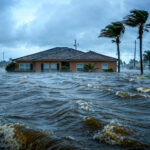More than 50 severe flood events around the world caused combined economic losses of $82 billion in 2021, while insured losses stood at slightly more than $20 billion—more evidence of a large ongoing global insurance protection gap of 75%, according to Swiss Re Institute’s latest sigma report.
Overall, natural catastrophes in 2021 resulted in a total global economic loss of $270 billion and insured losses of $111 billion, the fourth highest on sigma records. “This continues the long-term trend of insured losses increasing by an average of 5-7 percent annually worldwide,” said the report titled “Natural catastrophes in 2021: the flood gates are open.” (The “insurance protection gap” is the difference between total economic losses and the amount that is covered by insurers. For example, in 2021, the protection gap for flood risks was 75 percent).
The economic losses for 2021 rose by $10 billion after adding the costs of manmade losses, with insurance covering $8 billion of that amount. In 2020, global manmade losses amounted to $14 billion, with insurance covering $10 billion of that total.
While Hurricane Ida was the costliest single natural disaster in 2021, secondary peril events—such as severe convective storms (SCS), floods and wildfires—once again accounted for more than 70 percent of all insured losses from natural catastrophes over the year.
Last year was the first year on record when two secondary peril events each generated losses in excess of $10 billion (winter storm Uri and the flooding in Europe), the report noted.
The flooding in Europe in July 2021 was the costliest natural disaster on record in the region with economic losses of $41 billion and insurance losses of $13 billion. Swiss Re said the European floods marked only the second time insured losses from a standalone flood event surpassed $10 billion, after the floods in Thailand in 2011. These two events “demonstrate that the insured loss potential from single flood events today can equal and even exceed losses from primary peril events.”
Diving into the topic of flood as a secondary peril, Swiss Re said floods represented 31 percent of global economic losses from natural catastrophes during 2021, only 2 percent less than tropical cyclones, Swiss Re continued.
For example, during the past decade, there were three times as many large flood events as there were tropical cyclones and 1.2 times as many floods as SCS. “The devastation wreaked by floods reflects in the associated economic losses, which are consistently among the highest of all perils each year, alongside those from tropical cyclones and earthquakes,” Swiss Re said.
Since 2011, economic losses from floods amounted to 23 percent, which is the second highest loss after tropical cyclones, the report continued. However, Swiss Re Institute found that “over the past decade only 5 percent of severe flood losses were insured in emerging markets and 34 percent in advanced economies, indicating a large global protection gap.”
Swiss Re warned that such flood events are likely to increase in frequency and severity due to climate change, urbanization and the inadequacy of flood defense infrastructure in many countries.
“Floods affect nearly a third of the world population, more than any other peril. In 2021 alone, we witnessed more than 50 severe flood events across the world,” commented Martin Bertogg, head of Catastrophe Perils at Swiss Re, in a statement. “Given the scale of devastation, flood risk deserves the same attention and risk assessment rigor as primary perils such as hurricanes.”
“Climate change is anticipated to cause more frequent and more extreme weather events,” said the report. “Growing populations, rapid urban development and the accumulation of economic wealth in disaster-prone areas are contributing to the ever-growing catastrophe losses.”
Source: Swiss Re
Photograph: Nathan Fabre checks on his home and boat destroyed by Hurricane Ida, Sunday, Sept. 5, 2021, in Lafitte, La. “We lost everything,” said Fabre about the destruction of his home. Photo credit: AP Photo/John Locher.




















 Surviving the ‘Silver Tsunami’: Closing the Talent, Skills Gap in Underwriting
Surviving the ‘Silver Tsunami’: Closing the Talent, Skills Gap in Underwriting  Auto Insurer Files $450M Fraud RICO Case in NY
Auto Insurer Files $450M Fraud RICO Case in NY  East Coast High-End Car Theft Ring Busted
East Coast High-End Car Theft Ring Busted  Moody’s: Rising Flood Risks Posing Greater Challenges for Eastern and Southern U.S.
Moody’s: Rising Flood Risks Posing Greater Challenges for Eastern and Southern U.S. 




